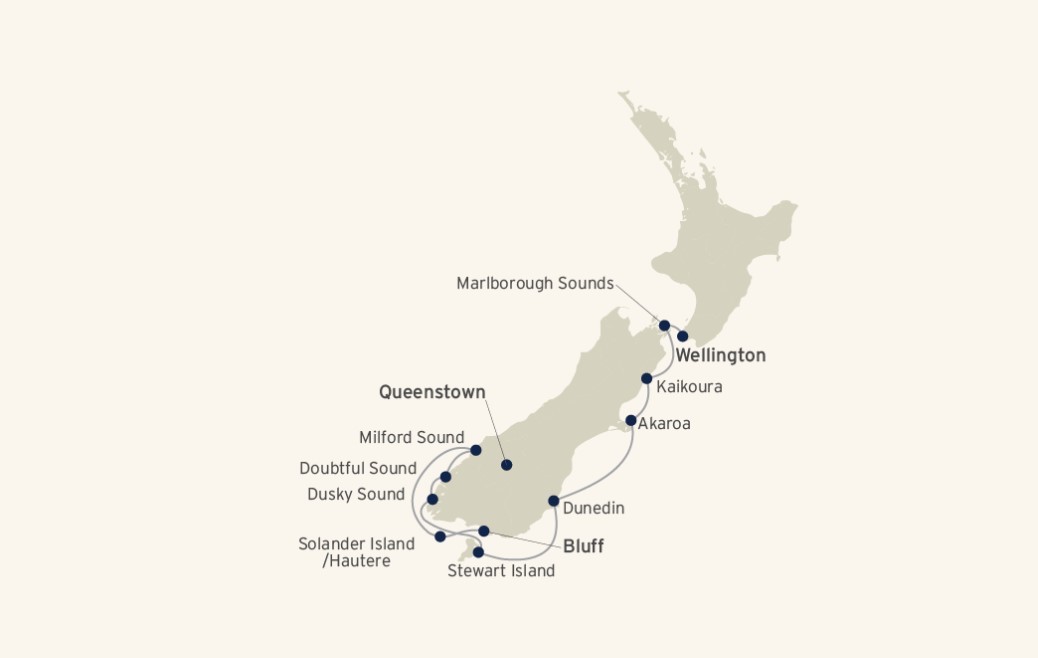
Join Coral Adventurer to explore the natural beauty of New Zealand’s South Island and Fiords departing Bluff. Embark on an unforgettable adventure through the renowned World Heritage region of the Fiordland National Park, as you explore the stunning Dusky Sound, Milford Sound, and Doubtful Sound on the remote west coast of New Zealand. Visit the spectacular Milford Sound, where the sheer cliffs plunge into the glacial waters and cascading waterfalls spring from the lush mountain surrounds. This is truly one of the world’s most spectacular natural landscapes. Stroll through the serene forests of Ulva Island and catch a glimpse of some of the country’s most iconic birds. Explore historic Dunedin with its rich blend of both Māori and Scottish heritage. At days end, return to Coral Adventurer and indulge in New Zealand’s renowned produce and wine. An expedition by small ship is the ultimate way to immerse yourself in the remote wonders of the New Zealand coast.
- Cruise past Solander Island, a trio of uninhabited volcanic islets with rare wildlife, ferns, orchids, and birds such as fernbirds, snipe, and white-fronted terns
- Explore Fiordland National Park, a World Heritage site with 14 fiords carved by glaciers over thousands of years. Our voyage visits the iconic Milford, Dusky and Doubtful Sounds over three epic days
- Take a guided tour or enjoy time to yourself in Dunedin, a city settled in and around an ancient volcanic crater, with rich Scottish and Māori heritage and unique cathedrals and architecture
- Stroll through the quiet forests of Ulva Island to spot New Zealand’s iconic birds, including the Stewart Island Weka, South Island Saddleback, Yellow-and Red-crowned Parakeet (Kakariki) and Rifleman (New
Zealand’s smallest bird)
- Visit Kaikoura, renowned as amongst the best whale watching destinations in the world to sight the breaching sperm whales
- Enjoy a special Christmas at sea as we sail by Solander Island and ring in the New Year with a memorable day in Akaroa, a small and scenic settlement with a unique French heritage
Prices quoted here are often dependent on currency fluctuations. Please check with (01432 507450 or info@small-cruise-ships.com) for the very latest price, which may well be cheaper than the one advertised here.


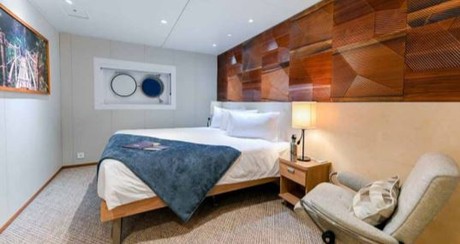
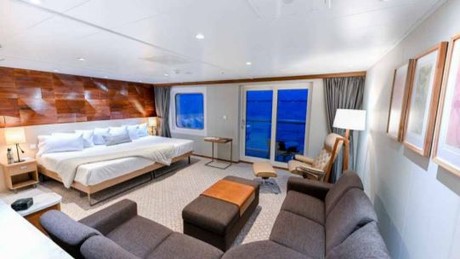
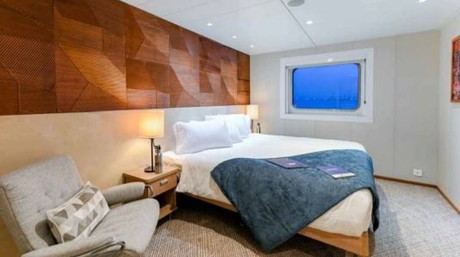
Enjoy a complimentary transfer by coach from Queenstown check-in to board at 4:00pm at Bluff, New Zealand. There is time to settle into your stateroom before our 5:00pm departure towards Dusky Sound cruising past Solander Island. Spend the day exploring Coral Adventurer and all her facilities. Take in the sights while enjoying Captain’s welcome drinks and meet your crew and fellow passengers.
On our day at sea, we will cruise past Solander Island. The Solander Islands, with the Māori name Hautere translating to ‘flying wind’, are a trio of uninhabited volcanic islets that lie just beyond New Zealand’s South Island. Aboard the Endeavour, Captain James Cook spotted the islands in early 1770, and was named after a Swedish scientific crew member on board, Daniel Solander. The islands have only been known to be inhabited briefly due to marooning or shipwreck. With one third of the wildlife on the islands being incredibly rare, the bulk of the species include ferns and orchids. Birds known to call the islands home include fernbirds, snipe and white-fronted terns with the islands being declared an Important Bird Area as it is a breeding site for common diving petrels and Buller’s albatrosses amassing some 5000 pairs. The area is well-known for whale migration with sightings of extraordinarily large sperm whales.
Fiordland National Park, a World Heritage site once described as the Eighth Wonder of the World by author Rudyard Kipling, is characterised by 14 fiords carving through just 215km of coastline. These fiords were carved by glaciers over thousands of years, and you will see waterfalls cascading down the sheer cliffs, rainforest cloaking the steep ridges, and granite peaks reflected in the deep shimmering waters. These mostly inaccessible and awe-inspiring landscapes were the mysterious source of powerful pounamu (New Zealand Jade), gathered by Māori from the riverbeds and boulders of the South Island – the only place it occurs. While some European settlers took shelter here, the deep isolation and rugged terrain thwarted all except the toughest from staying. Many of the flora and fauna species have developed in relative isolation, so many of the diverse plants and animals are unique to the area. Enter Fiordland National Park at dramatic Tamatea / Dusky Sound, and cruise among towering cliffs and sheet granite walls of Facile Harbour, cascading waterfalls, pass some of the 365 small islands and explore the depths of the inlets in the zodiacs. Inaccessible by road, Tamatea / Dusky Sound is the largest and most complex of the Fiordland Sounds. It is also a designated Important Bird Area for the Fiordland Penguins that breed here. We will also encounter the fur seals of Luncheon Cove.
This afternoon, we enter Milford Sound / Piopiotahi to a world-famous view of Mitre Peak, rising some 1,682 meters. Its triangular silhouette rises opposite beautiful Stirling Falls, falling from the top of a 162m high cliff between two towering ridges into the inky dark water. You may have a chance to feel the spray from the waterfall – according to Māori legend, it will make you ten years younger! The steep overhanging cliffs are awe-inspiring as we cruise to Harrison Cove, where an ancient glacier entered the fiord, and visit Bowen Falls.
Doubtful Sound / Patea is the deepest and widest fiord, flanked by towering cliffs and adorned by cascading waterfalls. The stillness and silence of this Fiord is compelling and unforgettable. We will cruise into Doubtful Sound / Patea, and past the outer Seal Islands, Nee Islets and through ‘the Gut’, before cruising by Blanket Bay and into Te Awa-o-Tū / Thomson Sound. You may spot fur seals lounging on the rocks, pods of dolphins, and the Fiordland penguin.
Known in Māori mythology as Te Punga o Te Waka – The Anchor Stone of Maui’s Canoe’ – Stewart Island (Rakiura) is New Zealand’s little known ‘third island’. Apart from the communities on the island, many people never venture to remote Stewart Island. Nearby Ulva Island is also found within the Rakiura National Park, offering a predator-free environment for rare and endangered birds including South Island Saddleback, Stewart Island Weka, New Zealand Pigeon/Kereru, South Island Kaka, Yellow- and Red-crowned Parakeet (Kakariki), Morepork, Rifleman (New Zealand’s smallest bird), New Zealand Fantail, South Island Tomtit, Stewart Island Robin, Yellowhead (Mohoua), Brown Creeper, Grey Warbler, New Zealand Bellbird and Tui. Spend two days interacting with local communities, exploring national parks, and spotting some of the endemic and endangered local wildlife.
Dunedin, settled in and around an ancient volcanic crater, is known for its Scottish and Māori heritage. Named after the Scottish Gaelic name for Edinburgh, the city’s heritage buildings, cathedrals, and charming atmosphere share an old-world atmosphere. Dunedin City is regarded as New Zealand’s architectural heritage capital. The Otago Peninsula is an area of exceptional diversity, and we will be welcomed with sights of the world’s only mainland breeding colony of northern royal albatross and a colony of the rare, yellow-eyed penguin. There will be a choice of included excursions with local operators – choose between a coach tour of the Otago Peninsula or Dunedin City Highlights. Alternatively, take time to explore the city at your leisure: Visit the famous Speight’s Brewery, art gallery, or New Zealand’s oldest botanic gardens.
This morning, sail into the long harbour of Akaroa, formed by the breached volcanic crater that makes up the Banks Peninsula. The village of Akaroa has the unique identity of being the only French settlement in New Zealand, and its charming cottages and French street names still carry that identity today. Ringed by the pastoral rolling hills of the Peninsula, the scenic village was once a bustling whaling outpost. Here, choose between two included excursions: a harbour cruise to spot marine wildlife, or a tour to visit the world’s largest colony of little penguins at Pohatu Bay, with the chance to learn more about the conservation efforts that are protecting them. A variety of short walks are available into the surrounding nature reserves, guided by our expedition team.
Surrounded by the breathtaking snow-dusted Seaward Kaikoura Ranges, the picturesque town of Kaikoura is renowned as possibly the best whale watching destination in the world. Kaikoura is one of the very few places it is possible to observe the Sperm Whale. Aboard our Xplorer tender vessels, explore the ocean in search of these amazing mammals, as well as fur seals, dusky and Hector’s dolphins and other migratory whales. Kaikoura means ‘to eat crayfish’, and you may have the opportunity to taste the seafood available here. You will also have the opportunity to walk through this small town to visit the museums, galleries, and cafes, before joining the expedition team on a guided walk over the peninsula to marvel at the spectacular scenery.
The ancient river valleys that form the Marlborough Sounds make up 20% of New Zealand’s coastline. The webs of sunken channels are surrounded by forest-cloaked peaks and vineyards, all of which present a breathtaking view from any perspective. This lush region produces much of New Zealand’s seafood, and 80% of its wine. The fertile soil in this region supported the country’s first known Polynesian settlement in the late 1200s AD at Wairau Bar. Anchor at historic Ship Cove on your first morning here, before spending the day exploring Queen Charlotte Sound. Over the next two days discover the dolphins and seals of the sounds with marine spotting from the Xplorer and enjoy wonderful birdwatching on walks through Motuara Island birdlife sanctuary. Be guided by our expedition team and lecturers, there will be options to hike a section of the spectacular Queen Charlotte Track, or shorter walks available. The history of the region is also brought to life with our visit to Ship Cove, where informative storyboards tell of Captain Cook’s time here.
This morning, as we arrive into Wellington, farewell Coral Adventurer, crew, and new-found friends as we disembark. A complimentary post-cruise transfers to the airport or CBD will be available.
This itinerary is an indication of the destinations we visit and activities on offer. Throughout the expedition we may make changes to the itinerary as necessary to maximise your expeditionary experience. Allowances may be made for seasonal variations, weather, tidal conditions, and any other event that may affect the operation of the vessel. Coral Expeditions suggests that you do not arrive on the day of embarkation or depart on the day of disembarkation due to any changes that may occur in scheduling.
Coral Adventurer
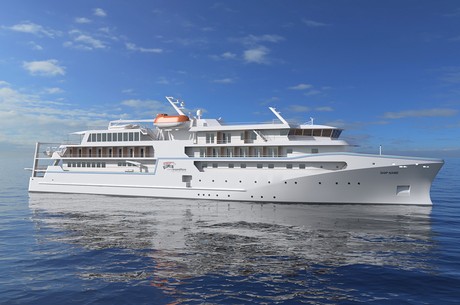
| Length | 93.40 metres |
|---|---|
| Launched | 2018 |
| Cabins | 60 |
Launched in 2018 withher maiden voyage in 2019, Coaral Adventurer has been designed and built to take you closer to unspoilt vistas in comfort, style and safety. A culmination of two years of design and three decades of passion for expedition cruising.
BIGGER IS NOT BETTER
At a time when cruise ships get larger and glitzier, we remain stubbornly compact and intimate. Our ships are designed to take you to unspoilt destinations not accessible to large ships. We want you to have the luxury of space, dine with whom you please, or find your quiet corner on deck. So Coral Adventurer has just 60 spacious cabins. This preserves the intimate atmosphere we are known for without sacrificing the stability and comfort of a true ocean going vessel.
BUILT FOR DISCOVERY
The Coral Adventurer features the trademark dual ‘Xplorer’ tenders cradled on a hydraulic platform slung off the back of the ship, enabling our guests to go ashore in comfort and ease. The shallow draft of the ship enables us to go closer to shore than larger ships. Together with a renowned expedition team, this new ship will offer the most advanced expedition capabilities of any small ship afloat.
BUILT FOR COMFORT
With active stabilisers dampening sea motion, mostly balcony cabins, and interiors designed with the colours and textures of tropical Queensland, the Coral Adventurer is a comfortable ship. She features promenade decks, generous communal areas that accommodate all guests, a passenger elevator, and an open kitchen where you can observe our chefs whip up small batch cuisine from locally sourced ingredients.
BUILT FOR PERSONAL SERVICE
The Coral Adventurer will continue a proud tradition of Australian flagged vessels with friendly and professional Australian crew. The onboard atmosphere remains refreshingly informal and intimate. Take your seat at our bridge lounge, chat with the captain at your leisure or accompany our chefs on a market tour.
Food and wine features
* Single seating dining area with communal ‘wine table’ finished with Australian stone; serving buffet breakfast and lunch, and multi-course table d’hote dinners
* Showcase galley visible to guests for fresh small-batch cuisine featuring Australian produce
* Multiple indoor and outdoor bars, including the Explorer bar on the sundeck for sunset drinks with 180 degree views
* Curated wine cellar featuring modestly priced boutique wines for daily drinking and exceptional vintage Australian reds.
Guest comfort
* All outside guest cabins with en-suite bathrooms; majority have private balcony
* Active stabilisers to dampen sea motion
* Gym equipped with elliptical trainers and treadmills
* Passenger elevator
* Wi-Fi available in all guest areas
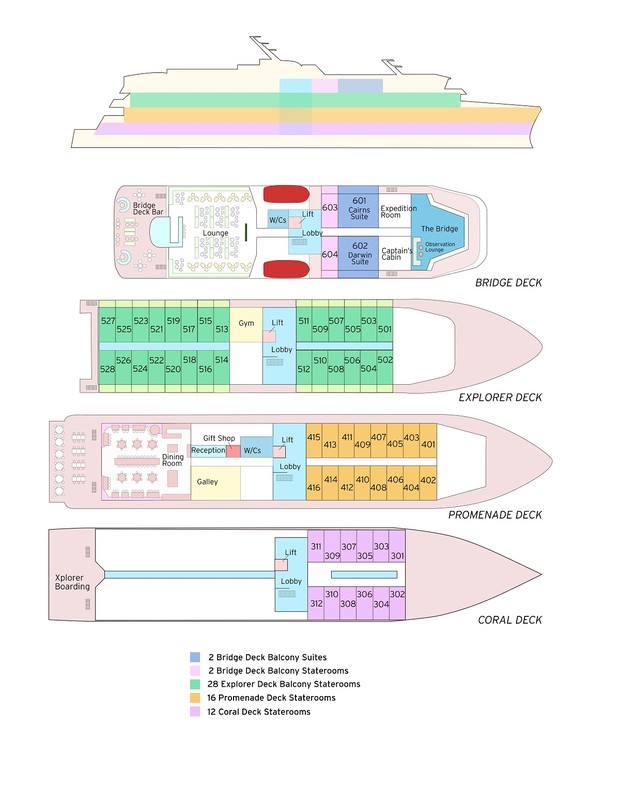
Includes
- All excursions with our Expedition Team
- Use of Xplorer, Zodiacs and Kayaks
- Daily lectures and briefings with Guest Lecturers
- All meals, chef-prepared on board
- Captain’s welcome and farewell events, and open bridge access
- Selected wines, selected beers and house spirits, juices, and soft drinks served with lunch and dinner
- 24-hour barista-style coffee and tea station
- All entrance fees to National Parks, ports, traditional owner fees and charges imposed by governing authorities
- Tips and gratuities
- Use of all onboard facilities, incl. a reference library
- Expedition diary, along with a photo and video gallery documenting the highlights of your voyage
- Post-cruise transfers (in most destinations)

